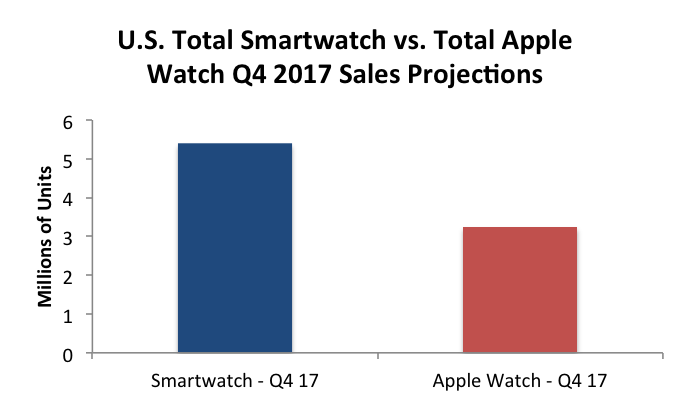LTE and incremental improvements will lead to continued smartwatch dominance for Apple
While the smartwatch is still not a mass-market device, with roughly 9.5 percent penetration among U.S. adults as of the middle of 2017, Apple has certainly been doing its part to push the category in that direction. Apple currently owns more than 50 percent of the U.S. smartwatch market and the newly announced Apple Watch Series 3 will further bolster Apple’s status as the top smartwatch maker in the industry. While the Series 3 doesn’t change anything about the Apple Watch in terms of design, it sports a number of subtle refinements, in addition to finally adding an on-device LTE radio. While on-device LTE does not bestow the Series 3 with a wide range of new capabilities, being able to fully use the Watch without the need to have a tethered iPhone nearby will provide a strong reason for early Apple Watch owners and potential new buyers to upgrade or jump into the category. In addition, the ability for the Series 3 to be linked to the user’s main mobile phone number, as well as accessories like Apple’s AirPod wireless headphones, bolster its use case as an independent device.
Growth will also be driven by the lower price on the Apple Watch Series 1 (coupled with expected holiday discounting from retailers), will help drive sales with more price-sensitive buyers. Another potential wildcard that will further bolster Apple Watch sales will be the response from wireless carriers. Now that the Apple Watch has an LTE enabled variant, the carriers will be strongly incentivized to push Apple Watch sales and bundle the devices together with iPhone upgrades on zero-interest device financing plans. Spreading the cost of an Apple Watch Series 3 over two-years on a consumer’s mobile phone plan has the potential to make the purchase much more palatable – just as it has for iPhones. In fact, T-Mobile has already announced that customers will be able to add the $400 Apple Watch Series 3 with LTE on its Equipment Installment Plan starting at $16.67 per month. As a result, NPD Connected Intelligence is forecasting that Apple will sell roughly 3.25 million Watches in total in the U.S. during the Q4 2017 holiday season.

Enhancements beyond LTE
While on-device LTE is certainly the centerpiece capability on the Apple Watch Series 3, other more subtle enhancements will also improve usability and experience. On the hardware side, the most important aspect of the Series 3 is that the form factor and weight of the Watch are virtually unchanged, despite the addition of LTE. This was accomplished in part by integrating the cellular antenna into the screen. In addition, Apple claims that battery life is virtually unchanged, which had the potential to be a major Achilles heel with a power draining LTE chip. Another welcome hardware enhancement on the Series 3 is wireless charging, which will add to the convenience of a device that needs daily charging – especially with Apple’s announced AirPower charging pad, built to charge the iPhone, Apple Watch, and AirPods.
Beyond increased hardware performance, developments in Siri interactions on the Watch will also make for an improved experience. Prior to the Series 3, Siri was unable to respond verbally on the Apple Watch, which we believe is essential for a voice assistant on a small wrist-mounted device. An improved Siri experience will help unlock further Watch use cases and lead to more regular usage of basic features such as notifications, messaging, and navigation.
Finally, Watch OS 4 adds some additional fitness and health-related refinements, which shows that Apple is still positioning the Watch as a premium fitness device first. The most noteworthy additions include: better heart rate tracking, the ability to track a wider range of workouts, and a new Siri watchface that displays a wider range of relevant information and notifications. On the heart rate front, the Watch will also warn users of an elevated heart rate during inactivity, which Apple is using to analyze arrhythmias, as part of an FDA backed heart study.
The Competition
As we head towards the holidays, competition in the smartwatch space has been ramping up markedly, with the announcement of not just the Apple Watch Series 3, but also devices such as the Fitbit Ionic (the company’s first full smartwatch), and the Samsung Gear Sport. The common theme on both the Fitbit and Samsung devices is that they are positioned as premium fitness devices first – a strategy we are also seeing from Apple. While many of the technical specs and features are very similar to the Apple Watch Series 3, Apple’s extensive ecosystem still gives it an overall advantage. The addition of on-device LTE is also likely to be a strong differentiator for Apple, given that neither Fitbit nor Samsung have that capability in their latest devices. As a result, we expect the Q4 2017 holiday season to be Apple’s best-ever quarter for Watch sales.


